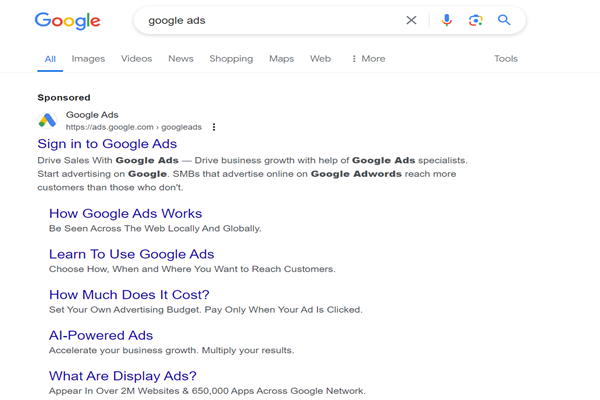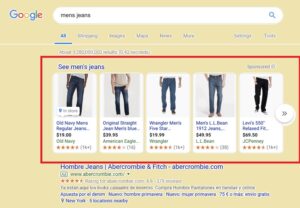Introduction to Google Ads
Google Ads, previously known as Google AdWords, and various types of Google Ads are powerful online advertising platform that businesses of all sizes utilize to promote their products and services on Google Search, YouTube, and other sites across the web. Understanding the various types of Google Ads is crucial for optimizing your marketing strategy and maximizing your return on investment (ROI).

Search Ads
What Are Search Ads?
Search Ads are text ads that appear on Google search engine results pages (SERPs) when users search for specific keywords. These ads are typically displayed above or below the organic search results, making them highly visible to potential customers.
Benefits of Search Ads
- High Intent Traffic: Users who see Search Ads are actively searching for information related to the advertised product or service, indicating strong purchase intent.
- Precise Targeting: Advertisers can target specific keywords, ensuring their ads reach the most relevant audience.
- Measurable Results: Detailed analytics allow advertisers to track performance and optimize campaigns for better results.
Display Ads
What Are Display Ads?
Display Ads are visual advertisements that appear on Google’s Display Network, a collection of over two million websites, apps, and videos. These ads can be in various formats, including banners, images, and videos.

Benefits of Display Ads
- Wide Reach: Display Ads can reach a vast audience across numerous websites and apps.
- Visual Appeal: Eye-catching visuals can effectively capture the audience’s attention and enhance brand awareness.
- Remarketing Opportunities: Display Ads can be used for remarketing, targeting users who have previously visited your website but did not convert.
Video Ads
What Are Video Ads?
Advertisements that show up on YouTube and other Google partner websites are called video ads. These ads can be skippable, non-skippable, or bumper ads, providing flexibility in how advertisers engage their audience.
Benefits of Video Ads
- Engaging Format: Videos can effectively convey complex messages and engage viewers emotionally.
- Extensive Reach: YouTube has over two billion monthly active users, offering substantial audience potential.
- Targeting Options: Advertisers can target specific demographics, interests, and behaviors, ensuring their ads reach the right viewers.
Shopping Ads
What Are Shopping Ads?
Shopping Ads, also known as Product Listing Ads (PLAs), display detailed information about specific products, including images, prices, and merchant names. These ads appear on Google Shopping, Google Search, and partner websites.

Benefits of Shopping Ads
- High-Intent Traffic: Shopping Ads attract users who are actively searching for products, making them more likely to convert.
- Visual Appeal: Images and detailed product information help attract and inform potential buyers.
- Competitive Edge: Comparisons between different merchants’ products can increase visibility and drive sales.
App Ads
What Are App Ads?
App Ads promote mobile applications across Google’s extensive network, including Google Search, Google Play, YouTube, and the Display Network. These ads are designed to drive app downloads and user engagement.
Benefits of App Ads
- Cross-Platform Reach: App Ads can appear across multiple Google properties, maximizing exposure.
- Automated Targeting: Google uses machine learning to optimize targeting and placement, improving campaign performance.
- User Engagement: App Ads can encourage users to download and interact with your app, boosting overall engagement.
Local Ads
What Are Local Ads?
Local Ads are designed to drive offline store visits and local engagement. These ads appear on Google Search, Google Maps, and the Display Network, targeting users in specific geographic locations.

Benefits of Local Ads
- Increased Foot Traffic: By targeting local users, these ads can drive more visitors to physical stores.
- Local Relevance: Ads are shown to users in proximity to the business, enhancing relevance and likelihood of conversion.
- Enhanced Visibility: Appearances on Google Maps and local search results increase visibility for nearby users.
Discovery Ads
What Are Discovery Ads?
Discovery Ads are native ads that appear across Google’s Discover feed, YouTube, and Gmail. These ads blend seamlessly with the content users are viewing, providing a non-intrusive advertising experience.
Benefits of Discovery Ads
- Engaging Format: Native ads that blend with content can enhance user engagement and interest.
- Wide Reach: Appear across multiple platforms, including Google Discover, YouTube, and Gmail.
- Targeting Flexibility: Utilize Google’s audience targeting capabilities to reach the most relevant users.
Conclusion
Understanding the different types of Google Ads is essential for creating a successful online advertising strategy. Each ad type offers unique benefits and can be tailored to meet specific marketing goals. By leveraging the right combination of Search, Display, Video, Shopping, App, Local, and Discovery Ads, businesses can enhance their online presence, reach their target audience, and achieve their advertising objectives.
How to determine the appropriate Google Ad types for your campaigns
Audience consideration: Think about your target audience, customer demographics, and online habits. Use these details to determine which ad type will effectively engage potential customers.
Industry analysis: Certain industries benefit more from specific ad types. For example, e-commerce businesses thrive with Shopping ads, while local services can maximize ROI through Local Services Ads.
Budget allocation: Cost varies across ad types. Allocate your budget wisely, choosing ads that provide the best balance of cost-effectiveness and potential reach.
Business objectives: Align your ad choice with your goals, whether brand awareness, lead generation, or direct sales.
Experimentation: Test different ad types to discover which generates the best results for your campaigns. Continuous optimization based on performance metrics is key to effective advertising.
Frequently Asked Questions About Google Ads
Which Google ad type is best for my business?
- It depends on your goals, budget, and industry. Refer to the detailed ad type descriptions above to make an informed choice.
How can I lower my Google Ads cost per lead?
- Regularly optimize your campaigns, targeting keywords more precisely, and refine your ad content to improve Quality Scores.
Can I use multiple ad types simultaneously?
- Yes, using a mix of ad types can broaden your reach and enhance overall campaign effectiveness.
Are Google Ads suitable for small businesses?
- Absolutely! With flexible budgeting and precise targeting, Google Ads can benefit businesses of all sizes.
How long should I run my Google Ads campaign?
- Campaign duration depends on your objectives. Continuous monitoring and optimization can help maintain effectiveness over time.
Effective utilization of Google Ads involves a blend of strategic planning, meticulous execution, and consistent evaluation. This guide should serve as a comprehensive resource for navigating the multifaceted world of Google advertising.

Leave a Reply